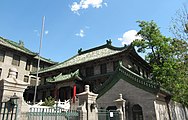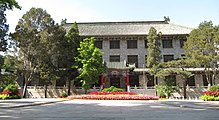Peking Union Medical College
Peking Union Medical College, founded in 1906, is a national public medical college located in Dongcheng, Beijing, China.
It is affiliated with the National Health Commission. The college is part of the Double First-Class Construction. The school operates the Peking Union Medical College Hospital and hosts a joint 8-year clinical medicine science program with Tsinghua University.
北京协和医学院 (中国医学科学院) | |||||||
 | |||||||
| Type | Public | ||||||
|---|---|---|---|---|---|---|---|
| Established | 1917 | ||||||
| President | Wang Chen | ||||||
| Location | Beijing , China 39°54′39″N 116°24′54″E / 39.9107°N 116.4149°E | ||||||
| Campus | Urban | ||||||
| Affiliations | National Health Commission | ||||||
| Website | www | ||||||
| Chinese name | |||||||
| Simplified Chinese | 北京协和医学院 | ||||||
| Traditional Chinese | 北京協和醫學院 | ||||||
| |||||||

Peking Union Medical College students in the 8-year clinical medicine program could receive a Peking Union Medical College diploma and degree signed by both the Peking Union Medical College and Tsinghua presidents. It was merged with the Chinese Academy of Medical Sciences in 1957 and operates as one single institution with two names directly under the Ministry of Health, now the National Health Commission. It is the first medical school in China to introduce the 8-year MD program.
History

The Peking Union Medical College Hospital was founded in 1906. The American Board of Commissioners for Foreign Missions, the Board of Foreign Missions of the Presbyterian Church in the U.S.A., the London Missionary Society, and later, the Board of Foreign Missions of the Methodist Episcopal Church, the Society for the Propagation of the Gospel, and the Medical Missionary Association of London, together with the then-Chinese government cooperated in the foundation and development of the Medical College and maintained it until 1915. The Rockefeller Foundation was established in 1913 and in 1913-1914 the newly formed Foundation created a Commission, including Dr. Franklin C. McLean, to examine medical education in China. Dr Wu Lien-teh strongly supported the establishment of a new medical college in Peking and made a number of recommendations, all of which were adopted. One of its recommendations was that the Foundation - through a subsidiary organization - should assume financial responsibility for the college. On July 1, 1915, the recently established China Medical Board assumed full support of the Union Medical College, having previously acquired the property. The commission's members had included both William Welch, the first Dean of the Johns Hopkins Medical School, and Simon Flexner. The China Medical Board modeled the school after Johns Hopkins University School of Medicine following the recommendations of the Flexner Report, which set the foundation of modern Medical Education in the United States and Canada. The PUMC was reorganized in 1917 and celebrated its 90th anniversary with a ceremony attended by the president of Johns Hopkins University, the chair of the China Medical Board and representatives of the Rockefeller family and Rockefeller Brothers Fund. John Black Grant, M.D., M.P.H. was a founding faculty member of PUMC and served from 1921 to 1938 as professor and chair of its Department of Public Health. Dr. Grant is the father of James P. Grant, the third executive director of UNICEF.
The PRC government nationalized PUMC, describing it as a Rockefeller Foundation-created symbol of U.S. cultural imperialism,: 91 in January 1951. The Ministry of Health changed its name to China Union Medical College but did not radically alter the curriculum except to switch the language of instruction from English to Chinese. In 1952 the People's Liberation Army took charge of operations and remained in charge until 1956. The curriculum was militarized and shortened to one year in order to train army medical officers, and Soviet models were introduced. The basic orientation to Western medicine was maintained and the staff continued to do research and advanced surgeries.
In 1956, autonomy was restored, but the college continued to be criticized for its elitism, cosmopolitanism, and failure to "serve the people" during periodic campaigns. During the Cultural Revolution, the Peking Union Medical College was closed, and the hospital was renamed the Beijing Anti-Imperialism Hospital (北京反帝醫院). In 1979, it reopened as the "Capital University of Medical Sciences" then returned to Peking Union Medical College (协和医科大学) in 1985.
Current status

Peking Union Medical College students traditionally attend Peking University biology department for their pre-meds portion of education. Since 2002, Tsinghua University has held a joint MD program in clinical medical science. Enrollment in the clinical medical science at PUMC is based on individual's performance in high school and National Exam score at graduation. The curriculum of clinical medical science is 8 years, accepts about 90 students each year and includes 2.5 years of pre-medical education in the School of Life Sciences at Tsinghua University; the students have their pre-med studies at Tsinghua University and are considered as students of both PUMC and Tsinghua University. The college also has its independent Graduate School, which recruits from other medical schools around the country. The health care services at Peking Union Medical College Hospital are widely believed in mainland China to be among the most technically advanced. Many prominent political and social leaders in China have sought medical treatment at the PUMC Hospital.
Peking Union Medical College has provided generations of leaders for academic and clinical medicine and related areas all over the world.
Peking Union Medical College is part of the Project 211 list of universities receiving national funding.
Rankings and reputation
Peking Union Medical College is listed as one of the top 400 universities in the World University Rankings. It is consistently ranked among the top medical schools in China and has ranked in the top 1 or 2 best nationwide, together with Capital Medical University among Chinese Medical Universities in the recognized Best Chinese Universities Ranking.
As of 2022, its "Biomedical Engineering" and "Public Health" were ranked in the top 75 in the world, while "Pharmacy & Pharmaceutical Sciences" and "Nursing" were placed in the top 150 in the world by the Academic Ranking of World Universities. As of 2022, its "Clinical Medicine" also ranked #121 globally by the U.S. News & World Report.
Academic Ranking of World Universities (ARWU)
Academic Ranking of World Universities (ARWU), also known as the Shanghai Ranking, is one of the annual publications of world university rankings. It's the first global university ranking with multifarious indicators.
| Year | Rank | Valuer |
|---|---|---|
| 2023 | 1 | ARWU Best Chinese Universities Ranking - Ranking of Chinese Medical Universities |
Research
The medical school is the home to 4 state key labs and 6 WHO collaborating centers including the:
- WHO Collaborating Center for Health and Biomedical Information
- WHO Collaborating Center for the Family of International Classification (WHO-FIC)
- WHO Collaborating Center for Nursing Policy-Making and Quality Management
- WHO Collaborating Center for Traditional Medicine
- WHO Collaborating Centre for the Community Control of Hereditary Diseases (Thalassemia)
- WHO Collaborating Centre for the Prevention and Control of Sexually Transmitted Infections
- The State Key Laboratory of Molecular Oncology
- The State Key Laboratory of Medical Molecular Biology
- The State Key Laboratory of Bio-active substances and the function of natural medicines
- The State Key Laboratory of Experimental Hematology
Hospitals
- Peking Union Medical College Hospital, Beijing
- Fuwai Hospital, Beijing
- Cancer Hospital, Beijing
- Plastic Surgery Hospital, Beijing
- Hematology Hospital, Tianjin
- Skin Disease Hospital, Nanjing
Notable alumni
Gallery
- Peking Union Medical College
See also
References
Citations
Sources
- Brazelton, Mary Augusta (2015). "Western Medical Education on Trial: The Endurance of Peking Union Medical College, 1949–1985". Twentieth-Century China. 40 (2): 126–145. doi:10.1179/1521538515Z.00000000056. S2CID 71731829.
- Bullock, Mary Brown. An American Transplant: The Rockefeller Foundation and the Peking Union Medical College (Berkeley: University of California Press, 1980).
- McLean, Franklin C, Ph.D., Guide to the Franklin C. McLean Papers 1881-1969 (Special Collections Research Center, University of Chicago Library, 2006).
External links

This article uses material from the Wikipedia English article Peking Union Medical College, which is released under the Creative Commons Attribution-ShareAlike 3.0 license ("CC BY-SA 3.0"); additional terms may apply (view authors). Content is available under CC BY-SA 4.0 unless otherwise noted. Images, videos and audio are available under their respective licenses.
®Wikipedia is a registered trademark of the Wiki Foundation, Inc. Wiki English (DUHOCTRUNGQUOC.VN) is an independent company and has no affiliation with Wiki Foundation.






